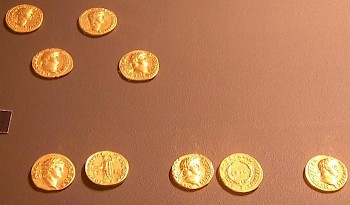Traiectum (Utrecht)
Q2199749Traiectum: name of a Roman fort in Germania Inferior, modern Utrecht.

Traiectum ("ford") was founded in the mid-first century, probably by the Roman general Gnaeus Domitius Corbulo, governor of Germania Inferior in 47, although a slightly earlier date becomes increasingly likely now that other forts along the Lower Rhine (e.g., Woerden) have been dated to 40 or 41, when the emperor Caligula paid a visit to Germania Inferior. The small fort was situated on what is now called the Domplein, and is still the center of Utrecht. The cemetery of the builders was identified in 2007 and is some 600 meters southwest of the fort itself.
Like all forts along the Lower-Rhine, Traiectum was destroyed during the Batavian Revolt. An interesting discovery in this context was a treasure of fifty gold pieces found in an officer's house, buried by a centurio who was never able to find his coins back.
Between 88/89 and 260, it was garrisoned by the Second cohort of Spanish foot soldiers (cohors II Hispanorum peditata). The fort was enlarged and rebuilt from brick and natural stone in c.210. The wall was almost a meter wide - a section of about seventeen meters was excavated in 2009. The castle was still functioning in the fourth century, and there are sufficient finds that there were people living and working within the walls in the fifth century, although it is not clear whether these were civilians or soldiers.
During the early Middle Ages, the Northumbrian monk Willibrord (668-739) visited Utrecht, and with authorization from the Franconian leader Pepin and pope Sergius III, built a church inside the ancient fort (695). This was the center of Christianity for the people called "Frisians", i.e., all inhabitants of the area north of the Rhine. Many stones were reused in the episcopal palace that was built by bishop Balderik (925).